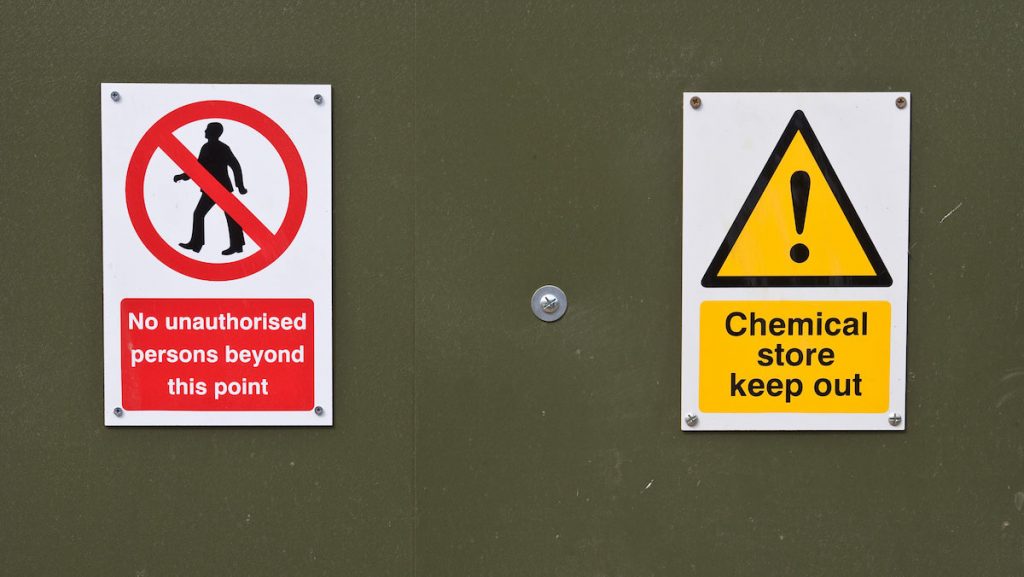The rules for legal storage of pesticides on farm
 © Tim Scrivener
© Tim Scrivener Pesticides must be stored properly to protect people and the environment, but stores can vary from purpose-built barns to converted buildings. We explain the rules so that you stay compliant and within the law.
See also: Video: How 3 farmers spruced up their spray stores
Can I build a spray store anywhere?
No. There may be restrictions, especially in environmentally sensitive areas like a groundwater protection zone, or upstream of a water supply catchment.
Before building new storage, you must check with your local authority, as you may need planning permission.
What areas should be avoided?
The store must be at least 4m away from straw, hay, paints, diesel, oil, fertilisers, paper, wood, gas canisters and other combustible materials.
It must also be 4m away from domestic dwellings and sources of ignition such as grain driers or welding activities.
Avoid building near drains, watercourses, boreholes and wells or other areas liable to flood.
What can I build a spray store out of?
The Health and Safety Executive (HSE) advises that the building should be made from materials which can resist fire for 30 minutes or more and retain leakage or spillage.
The bund – made of non-fragile material – should comprise or extend around the whole periphery of the store without being compromised by entrances and exits. The store itself should have a roof, be dry and protected from frost.
It is possible to convert existing structures instead of building from scratch. Shipping containers or lorry bodies may also be suitable.
What’s the best way to contain leaks?
This is normally done using a continuous sealed bund around the building – there should be no gaps around places such as doorways.
Ideally bunds should be integrated into the foundations, floor and walls and sunk below ground level.
It may be possible to bund stores by using a metal tank within the building, into which you can put spray cans and containers. This needs to be of sufficient capacity and clean.
How do you create a bund?
Avoid having a water supply passing through the bunded area. In newly constructed storage the bunds can be constructed as an integral part of the building, in the foundations, floor or walls.
When converting existing buildings the principles are the same – remove combustible materials, create a sealed bund and seal off internal drains.
How big should the store be?
Ensure the store is large enough for your peak requirements, including space for stock to be held if there is poor weather. Also allow space for empty and rinsed containers to be stored before disposal.
The store needs to be big enough to contain spillage or leakage equivalent to 110% of the total volume of products which are likely to be stored; this rises to 185% in an environmentally sensitive area.
What if I’m converting an existing building or putting a store in another building?
This is allowed, but any building being converted to, or housing a spray store, still needs to meet the same principles as a purpose-built one. Where possible, access to the chemical store should open directly to the outside.
What signs are needed?
There should be a general danger warning sign on the exterior of the building, as well as no smoking and no naked flames signs. There should be a list of emergency phone numbers and the procedure for fire and spillage.
Store security
Store doors and windows should be secure and kept locked when not in use.
What happens when I’m transporting sprays?
Pesticides should never be carried in the cabs of tractors or other vehicles. A vehicle with a floor to ceiling bulkhead in between the driver compartment and the load compartment is ideal.
If the vehicle does not have a bulkhead, ensure that the chemical container secure or kept in a cabinet is mounted on the exterior of the vehicle. Mark the load carrying area with general danger warning signs.
You must provide access to permanent and convenient facilities for workers to wash in if they become contaminated.
Products in the store
Only store products in their original labelled container. Growers are advised not to store mixed products (for example with adjuvant), but where this is unavoidable (such as due to interruptions caused by weather) make sure the product is labelled clearly and stored correctly.
Store powders above liquids – in case the liquids leak – and do not store plastic containers in direct sunlight.
Make sure there are no unapproved or unwanted pesticides in your store and dispose of any waste packaging safely and legally (for example via a licensed contractor). Keep an updated stock list available at the store and a copy elsewhere – make sure to use the older stock first.
What if there’s a spill?
Many product labels have specific advice about what to do in the event of a fire or spillage. For any spill, keep people and animals away from the area and wear appropriate protective equipment.
Keep a spill kit in the store containing; a brush, a shovel, absorbent materials or sand and an impermeable container.
Absorbent material (such as dry sand) can be used to soak up small spills of liquids, but make sure the material you use is inert and won’t react with the pesticide. Clear up any solids and material used to contain spills carefully and dispose of legally.
You must tell the Environment Agency and others that are at risk if the spill contaminates water or large amounts of soil.
Leaking containers should either be used straight away, or the contents transferred to another container that originally held the same product. Don’t use old food or drinks containers and dispose of any damaged containers legally.
More information:
- Downloadable PDF guidance from the HSE on storing pesticides.
- More on pesticide safety from the HSE.

